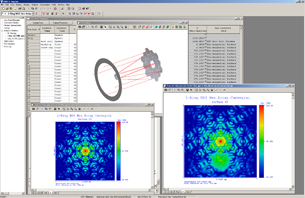Latest News
December 29, 2008
By DE Editors
 |
CODE V, the premier optical design software from Optical Research Associates (ORA; Pasadena, CA), now delivers faster optimization of complex optical systems by taking full advantage of parallel processing on multi-core architecture CPUs. In particular, both of its world-class local and global optimization routines in the release of CODE V 10.0, which are widely recognized as yielding superior results, are now enabled for multi-core operation. Optical designers can solve the most complex lens design problems in a fraction of the time needed using a single processor.
CODE V 10.0 also offers improved accuracy and ease of use for diffraction analysis. Its new Beam Synthesis Propagation (BSP) feature uses a beamlet-based, diffraction propagation algorithm to include diffraction effects through the entire optical system design. BSP delivers greater accuracy than using exit-pupil diffraction computations, or beam propagation based on FFT or angular spectrum methods. Systems with astigmatic beams, polarized input optical fields, low f-numbers (e.g., microlithography lenses), or non-contiguous pupils are accurately analyzed with BSP. The feature is also useful for near-field diffraction analysis and for optical systems where the amplitude or phase is modified near the focus, such as with a grating, phase plate, or spatial filter. Determining appropriate inputs for any beam propagation algorithm can be challenging, but BSP solves this by including a unique pre-analysis feature, which automatically provides appropriate input recommendations for your specific lens system, including input field sampling, resampling and output grid characteristics. Using pre-analysis, BSP will also estimate an execution run time for your lens system.
In addition, CODE V 10.0 delivers expanded language options with the introduction of French and German versions of its user interface.
For more information, contact Optical Research Associates.
Sources: Press materials received from the company and additional information gleaned from the company’s website.
Subscribe to our FREE magazine, FREE email newsletters or both!
Latest News
About the Author
DE’s editors contribute news and new product announcements to Digital Engineering.
Press releases may be sent to them via [email protected].






